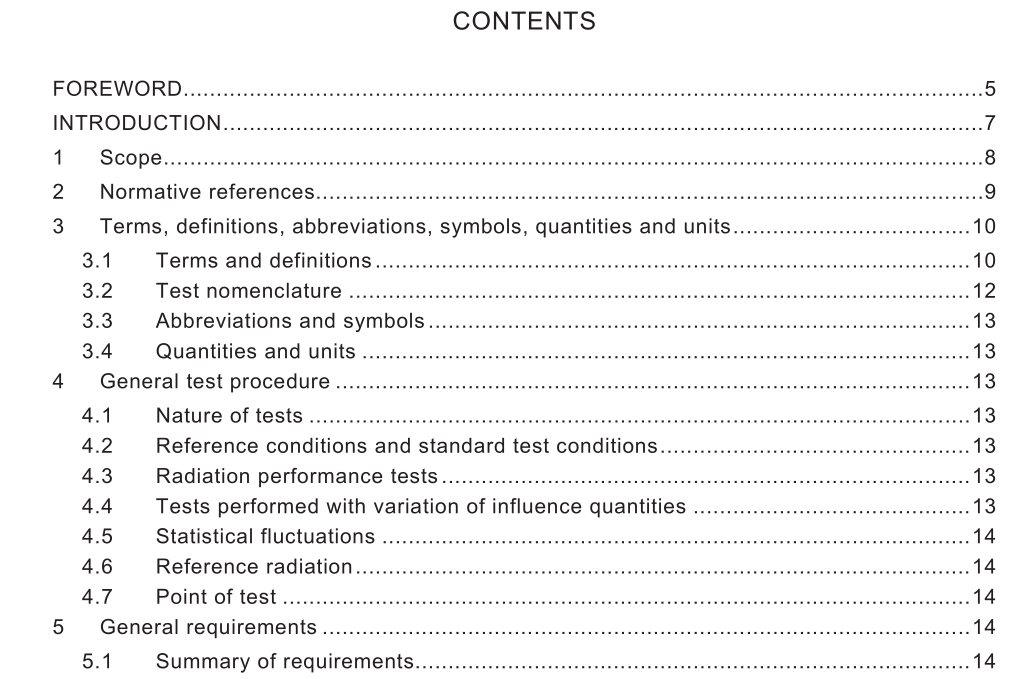BS IEC 61017 pdf download.Radiation protection instrumentation – Transportable, mobile or installed equipment to measure photon radiation for environmental monitoring
1 Scope
This International Standard is applicable to transportable, mobile or installed assemblies intended to measure environmental air kerma rates or air absorbed dose rates from 30 nGy⋅h –1 to 30 µGy⋅h –1 or ambient dose equivalent rates from 30 nSv⋅h –1 to 30 µSv⋅h –1 , or air kerma or air absorbed dose from 1 0 nGy to 1 0 mGy, or ambient dose equivalent from 1 0 nSv to 1 0 mSv, due to photon radiation of energy between 50 keV and 7 MeV. The measurable range of dose and dose rate can be extended by agreement between the purchaser and the manufacturer. This extension may be realized by combining more than one detector, for example NaI(Tl) scintillator and ionization chamber. For most environmental applications, instruments may measure over a more limited energy range of 80 keV to 3 MeV. NOTE 1 80 keV to 3 MeV has been chosen to cover the energies of the chief environmental and man-made radio- nuclides that contribute to the environmental dose. The term “dose” used in this standard means the quantity, air kerma, air absorbed dose, and ambient dose equivalent, that the instrument is intended to measure. If the assembly is to be used to measure these quantities in the area surrounding a nuclear reactor producing 6 MeV radiation from the 1 6 N isotope, it will be necessary to determine the response at this energy. An absorbed dose in air, which uses the same unit, Gy, as air kerma can be taken to have the same numerical value as air kerma under the condition of electron equilibrium. Passive devices such as Thermo-Luminescence Dosemeter (TLD), Optically Stimulated Luminescence (OSL) Dosemeter or Glass Radio-Photo Luminescence (RPL) Dosemeter are not covered by this standard. Installed assemblies should be capable of operating continuously. This standard does not provide for the measurement of beta and neutron radiation. The equipment covered by this standard comprises a detector assembly and processing circuits, which may be connected together either rigidly or by means of a flexible cable,
3 Terms, definitions, abbreviations, symbols, quantities and units
3.1 Terms and definitions For the purposes of this document, the following terms and definitions apply. NOTE General terminology concerning detection and measurement of ionizing radiation and nuclear instrumentation is given in IEC 60050-395 and IEC 60050-1 51 . 3.1 .1 ambient dose equivalent H*(10) dose equivalent at a point in a radiation field that would be produced by the corresponding expanded and aligned field in the ICRU sphere at a depth of 1 0 mm on the radius opposing the direction of the aligned field 3.1 .2 alarm audible, visual, or other signal activated when the instrument reading exceeds a preset value, falls outside of a preset range, or when the instrument detects the presence of the source of radiation according to a preset condition 3.1 .3 background level radiation field in which the instrument is intended to operate which includes background produced by naturally occurring radioactive material 3.1 .4 manufacturer designer and seller of the equipment 3.1 .5 monitor type 3.1 .5.1 installed radiation instruments that may be permanently mounted at a location for use Note 1 to entry: By agreement between manufacturer and purchaser, these assemblies should be provided with appropriate facilities for indicating readings. 3.1 .5.2 transportable radiation instruments not intended to be used whilst transported 3.1 .5.3 mobile radiation instruments that are mounted to moving platforms and that operate while in motion 3.1 .6 conventionally true value of quantity conventionally true dose or dose rate best estimate of the value of that quantity used for calibration of equipment; this value and its uncertainty shall be determined from a primary or secondary standard or by a reference instrument which has been calibrated against a primary or secondary standard 3.1 .7 error of indication difference between the indicated value of a quantity D I and the conventionally true value of that quantity at the point of measurement D T 3.1 .8 response response R of an assembly is the ratio of the assembly’s indicated value to the conventionally true value
BS IEC 61017 pdf download
